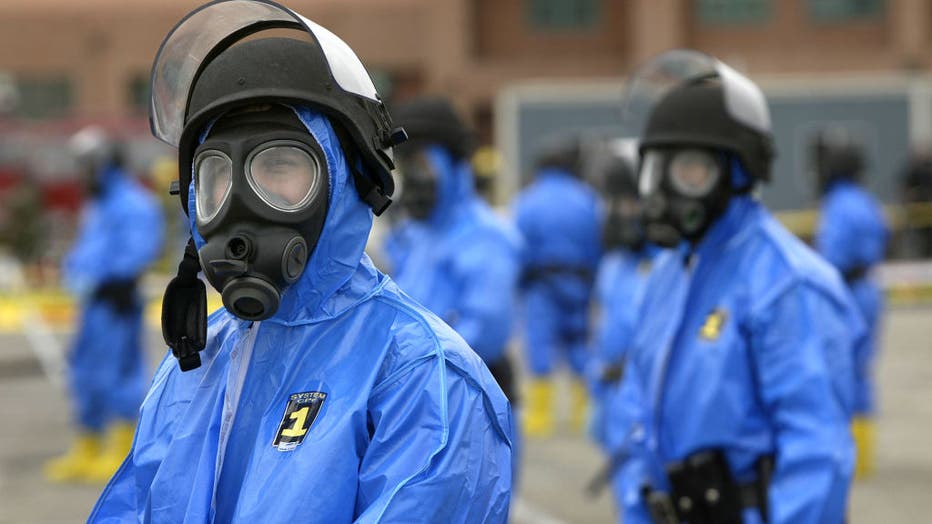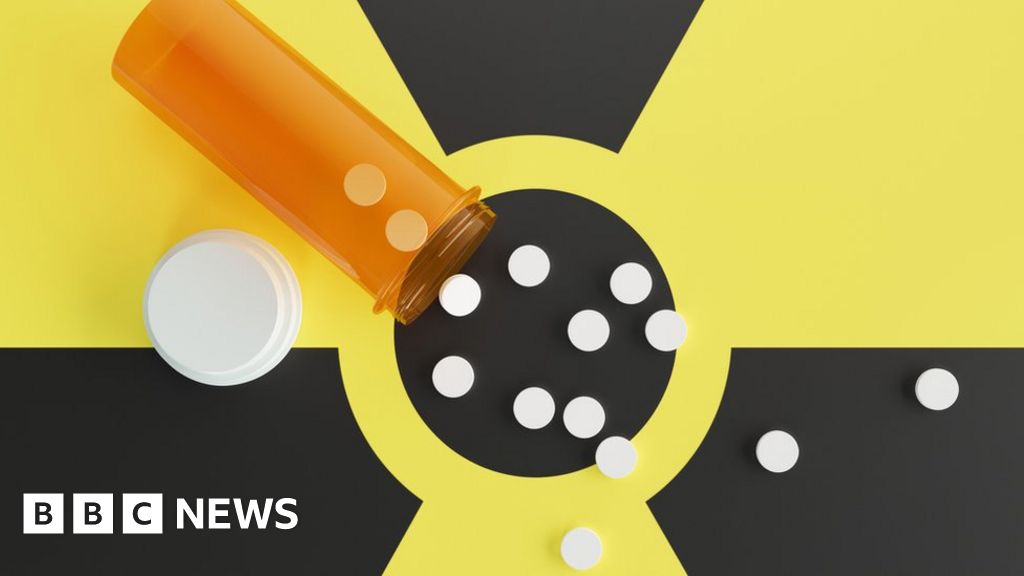HOPO 14-1 Dirty-bomb antidote: Drug trial begins in US
The first human trial of a new type of dirty-bomb-antidote pill, designed to remove harmful radioactive contamination from the body, is starting in the US.
The drug, HOPO 14-1, is thought to work against several materials that might be used in weapons, including uranium.
If it proves safe and effective it could guard against potential harm from nuclear accidents or terrorist attacks.
About 42 volunteers will try different doses, checking for side effects.
There will be “intensive safety monitoring”, with results from the phase one study expected in 2024, say the trial leaders from SRI International of Menlo Park, California, who are receiving funding from US government agency the National Institutes of Health.
What is a dirty bomb?
Also known as a radiological dispersal device or RDD, a dirty bomb is an explosive that has been mixed with radioactive material so that when it goes off there will be contamination of the blast zone.
A dirty bomb is not a nuclear bomb – it is “weapon of mass disruption” rather than “mass destruction”, says the US Nuclear Regulatory Commission.
The cloud of radiation from a dirty bomb could be dispersed within a few blocks or miles of the explosion, whereas a nuclear bomb could spread thousands of square miles.
Exposure to radiation can damage a person’s DNA, tissues and organs, leading to illnesses, including cancer, which is why an oral drug that could counteract some of the effects would be useful.
There are already two different drug injections that can be used to treat people who have been exposed to radioactive plutonium, americium or curium.
For decades, experts have also known that iodine tablets can be deployed to help protect people if radioactive iodine has been released into the environment; it was given to people in 1986 when a nuclear accident occurred at the Chernobyl power plant.
Another pill, Prussian blue (potassium ferric hexacyanoferrate), can help remove radioactive caesium and thallium.
If HOPO 14-1 works, it would be another to add to the stockpile, offering protection against uranium and neptunium in addition to plutonium, americium and curium.
There has not yet been a successful dirty-bomb attack anywhere in the world.
However, there have been attempts.
In 1996, rebels from Chechnya planted a bomb containing dynamite and radioactive caesium-137 in Moscow’s Izmailovo Park.
Security services discovered its location and it was defused.
In 1998, Chechnya’s intelligence service found and defused a dirty bomb that had been placed near a railway line in Chechnya.
HOPO 14-1 :Drug product for removing radioactive contaminants from the body.
Researchers begin human trials for oral drug to protect against dirty bomb exposure
LOS ANGELES – Researchers have begun the first-in-human clinical trial of an experimental oral drug that will hopefully be able to remove radioactive contaminants from inside the body has begun, the National Institutes of Health reported on Monday.
HOPO 14-1 will hopefully be able to be given to people in tablet form and will work against elements that can be used to make dirty bombs.
Dirty bombs are commonly known as explosive devices that are laced with radioactive substances.
If the trials prove optimistic, HOPO 14-1 could be used rather than intravenous methods in the event of an emergency.
The trial will consist of 42 healthy adults, aged 18 to 65, all of whom will be given varying doses of the experimental tablet.
Results from the trial are expected to be published next year.
What is a dirty bomb?
Technically known as radiological dispersion devices, dirty bombs are relatively primitive, imprecise weapons. They are much easier and cheaper to build than a nuclear device and also far less dangerous.
Dirty bombs use conventional explosives, such as dynamite, placed alongside radioactive material, which is then flung outward by the force of the blast. The amount of radioactive material dispersed, while dangerous, is not necessarily lethal.
The material used in the bomb could have been obtained from radioactive sources used in medicine and industry or from research facilities.
“A dirty bomb is really easy to make,” says Scott Roecker, vice president for the nuclear materials security program at The Nuclear Threat Initiative, a nonprofit based in Washington. “It’s a crude device.”

LOS ANGELES – AUGUST 5: Los Angeles police officers wearing contamination suits secure the area following the explosion of a “dirty bomb” during a simulated attack at a dock at the Port of Los Angeles on August 5, 2004 in Los Angeles, California. In
What damage can a dirty bomb cause?
The number of casualties and the extent of damage from a dirty bomb depends on many variables.
A key factor is the amount and type of conventional explosives that are used, which determine the magnitude of the blast.
The quantity and type of radioactive materials released are other factors, as are weather conditions — and especially the wind — at the time of the blast. A potentially wide area could be contaminated.
Most dirty bombs would not discharge enough radiation to cause death or even severe illness.
Low levels of radiation exposure usually do not cause any symptoms. People may not know whether they have been exposed because radiation cannot be seen, smelled or tasted.
How dangerous is a dirty bomb?
A dirty bomb would likely cause a limited number of deaths. Its main impact is psychological, which is why such devices are often referred to as “weapons of mass disruption.”
Dirty bombs are not for battlefield use, being deployed more obviously in urban areas, Roecker said.
“They’re more of a psychological weapon. When you’re trying to scare people, intimidate people, you’d use a weapon like this,” he said.
The radioactive dust and smoke can spread far and are dangerous if inhaled near the blast’s epicenter. The radioactive cloud would likely spread over several blocks, according to Roecker. But as radioactive material spreads through the atmosphere, it becomes less concentrated and less harmful.
Key factors in radiation exposure are what type of radiation it is, how long someone is exposed to it, and whether the radiation was absorbed through the skin, inhaled or consumed orally.
Specialized equipment is required to detect radiation. Contaminated homes, businesses and public services could be placed off-limits for months and need an expensive clean-up operation. source
HOPO 14-1 is an investigational drug product for removing radioactive contaminants from the body. It is an oral capsule designed to act as a defence against radioactive threats such as nuclear power plant accidents or dirty bomb attacks.[1][2] The active ingredient is the hydroxypyridinone ligand 3,4,3-LI(1,2-HOPO), which is a powerful chelating agent.[1][3] HOPO 14-1 works by selectively binding to heavy metals in the body and forming a complex that the body can naturally excrete.[4] The drug is also being studied as a treatment for other forms of heavy metal toxicity, including lead poisoning and exposure to gadolinium from MRI contrast agents.[5][6][7][8] HOPO 14-1 was developed at Lawrence Berkeley National Laboratory by actinide chemist Rebecca Abergel. Abergel and former postdoc Julian Avery Rees co-founded HOPO Therapeutics, a company commercializing HOPO 14-1 and other treatments for heavy metal poisoning.
References
- ^ Jump up to:a b “First-in-human trial of oral drug to remove radioactive contamination begins”. National Institutes of Health (NIH). 2023-05-15. Retrieved 2023-05-16.
- ^ Roberts M (2023-05-16). “Dirty-bomb antidote: Drug trial begins in US”. BBC News. Retrieved 2023-05-16.
- ^ Wang Q, Liu Z, Song YF, Chai Z, Wang D (March 2023). “Chelation Behaviors of 3,4,3-LI(1,2-HOPO) with Lanthanides and Actinides Implicated by Molecular Dynamics Simulations”. Inorganic Chemistry. 62 (10): 4304–4313. doi:10.1021/acs.inorgchem.2c04460. PMID 36847745. S2CID 257218983.
- ^ Abergel RJ, Durbin PW, Kullgren B, Ebbe SN, Xu J, Chang PY, et al. (September 2010). “Biomimetic actinide chelators: an update on the preclinical development of the orally active hydroxypyridonate decorporation agents 3,4,3-LI(1,2-HOPO) and 5-LIO(Me-3,2-HOPO)”. Health Physics. 99 (3): 401–407. doi:10.1097/HP.0b013e3181c21273. PMC 2921233. PMID 20699704.
- ^ Rees JA, Deblonde GJ, An DD, Ansoborlo C, Gauny SS, Abergel RJ (March 2018). “Evaluating the potential of chelation therapy to prevent and treat gadolinium deposition from MRI contrast agents”. Scientific Reports. 8 (1): 4419. Bibcode:2018NatSR…8.4419R. doi:10.1038/s41598-018-22511-6. PMC 5849765. PMID 29535330.
- ^ “This Anti-Nuclear-Contimation Pill Could Also Help MRI Patients”. Lawrence Berkeley National Laboratory (Berkeley Lab). 2019-09-12. Retrieved 2023-05-29.
- ^ “Rebecca Abergel – Bakar Fellows Program”. Bakar Fellows Program, UC Berkeley. 2021-10-21. Retrieved 2023-05-29.
- ^ “HOPO Therapeutics”. HOPO Therapeutics, Inc. 2023-05-29. Retrieved 2023-05-29.
- source
- source
- source

